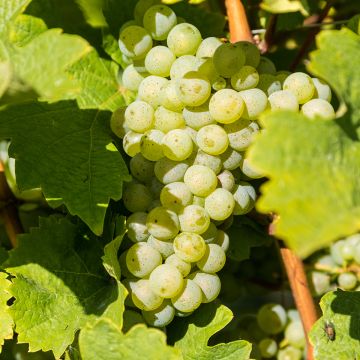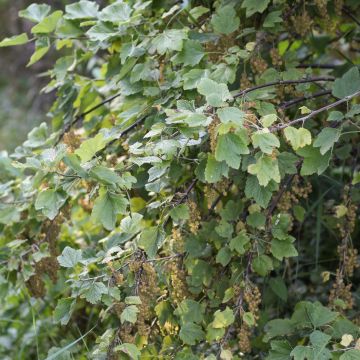

Vitis vinifera Timorasso - Grapevine
Vitis vinifera Timorasso - Grapevine
Vitis vinifera Timorasso
Common Grape Vine, European Grape
Special offer!
Receive a €20 voucher for any order over €90 (excluding delivery costs, credit notes, and plastic-free options)!
1- Add your favorite plants to your cart.
2- Once you have reached €90, confirm your order (you can even choose the delivery date!).
3- As soon as your order is shipped, you will receive an email containing your voucher code, valid for 3 months (90 days).
Your voucher is unique and can only be used once, for any order with a minimum value of €20, excluding delivery costs.
Can be combined with other current offers, non-divisible and non-refundable.
Home or relay delivery (depending on size and destination)
Schedule delivery date,
and select date in basket
This plant carries a 6 months recovery warranty
More information
We guarantee the quality of our plants for a full growing cycle, and will replace at our expense any plant that fails to recover under normal climatic and planting conditions.
Description
Vitis vinifera 'Timorasso' is an indigenous Italian grape variety mainly found in the provinces of Alessandria, Asti, and Cuneo in Piedmont. It was close to extinction in the 20th century but has recently experienced a revival in popularity driven by its reputation for high quality potential established by wine experts. With a generous structure and strong minerality, it is sometimes compared to great French white grape varieties. It is a vigorous vine with moderate yields, ripening in mid-September, providing wine grapes that were once also consumed as table grapes.
The wine grape vine (Vitis vinifera) grew wild over 5000 years ago. Numerous hybrids were created to vary colours, flavours, and uses. The 'Timorasso' vine is an authentically Piedmontese white wine grape variety, formerly the most widespread white grape variety in the region, also extending to the provinces of Pavia (Lombardy) in the north and Genoa (Liguria) in the south. Its decline is believed by some to date back to the early 20th century when, following the devastation caused by phylloxera, the vines were replanted with the more productive Cortese grape variety. Others argue that it was the socio-economic changes after the war that led to the abandonment of vineyards that were difficult to cultivate. At the end of the 20th century, a strong renewed interest in the grape variety, rediscovering its qualities, led by young winemakers from Tortona, reversed the trend.
The 'Timorasso' vine is a moderately climbing, vigorous shrub that can easily reach a height or spread of 4-5m if not pruned. Its final shape will depend on the pruning method used. This vine is a frugal sun-loving plant that is not demanding and prefers soil that is both clayey and stony, with a tendency towards limestone, but can be sensitive to prolonged drought. Its long stems cling to their support (trellis, espalier...) with the help of large green and twining tendrils. Its deep green foliage, with serrated edges turns a beautiful gold in autumn. Flowering occurs in May-June depending on the year and region, with small greenish flowers grouped in short and compact pyramidal and cylindrical clusters. It develops medium to large clusters of tight and powdery, conical-pyramidal grapes. The spherical or slightly egg-shaped berries are irregular and have thick, waxy, regular green-yellow skin that turns golden yellow when fully ripe, and a fleshy and juicy pulp. The grapes easily detach from the cluster. The vine is susceptible to botrytis on the clusters and to a lesser extent to millerandage, coulure, and sunburn. In its original environment, it thrives in poor, limestone or marly soils, sometimes in detrital soils, with abundant sunlight to allow the late ripening of the grape variety, but with generally moderate temperatures featuring high daytime temperatures and cool nighttime temperatures, at medium altitudes. This is to preserve the freshness necessary for a white grape variety and good ventilation to combat sensitivity to rot and powdery mildew favoured by humidity.
The grape variety mainly produces dry, still white wines characterised by a deep straw yellow colour, high acidity, and intense secondary and tertiary aromas, confirming its excellent ageing potential. On the palate, it reveals a relatively generous structure, occasionally suggesting oak ageing, although this is often not the case and a strong minerality. Among the most frequently mentioned aromas are honey, hazelnut, lemon, light spices, floral notes, apple, and apricot.
The 'Timorasso' grape is mainly consumed as wine. It can also be used for ornamental purposes, such as covering a pergola or training against a sunny wall. In the past, the grape variety was also used as a table grape. Finally, the grape pomace is sometimes distilled to produce "grappa".
Report an error about the product description
Vitis vinifera Timorasso - Grapevine in pictures


Plant habit
Fruit
Flowering
Foliage
Botanical data
Vitis
vinifera
Timorasso
Vitaceae
Common Grape Vine, European Grape
Western Europe
Other Grapevines
View all →Planting and care
Since the ravages of phylloxera at the end of the 19th century, the vine is now grafted onto different rootstocks resistant to this disease and adapted to different types of soil. These rootstocks come from American varieties naturally armed against this formidable parasite which is itself of American origin. Plant the Timorasso Vine in autumn, in deep, well-drained, even stony, clayey and limestone soil, in a sunny exposure, sheltered from strong winds. Incorporate 3 or 4 handfuls of fertiliser for fruit trees and 2 kg of composted manure into the planting soil for each vine-plant. The roots must not be in contact with the manure. After planting, prune above 2 large buds (buds) to grow two branches. Keep the most vigorous one, and tie it to a stake. Training pruning will follow.
The vine does not require regular fertiliser application, for good yield, on the contrary. Enrich the soil with potash, crushed horn or iron chelate, only every 2-3 years.
Planting period
Intended location
Care
This item has not been reviewed yet - be the first to leave a review about it.
Similar products
Haven't found what you were looking for?
Hardiness is the lowest winter temperature a plant can endure without suffering serious damage or even dying. However, hardiness is affected by location (a sheltered area, such as a patio), protection (winter cover) and soil type (hardiness is improved by well-drained soil).

Photo Sharing Terms & Conditions
In order to encourage gardeners to interact and share their experiences, Promesse de fleurs offers various media enabling content to be uploaded onto its Site - in particular via the ‘Photo sharing’ module.
The User agrees to refrain from:
- Posting any content that is illegal, prejudicial, insulting, racist, inciteful to hatred, revisionist, contrary to public decency, that infringes on privacy or on the privacy rights of third parties, in particular the publicity rights of persons and goods, intellectual property rights, or the right to privacy.
- Submitting content on behalf of a third party;
- Impersonate the identity of a third party and/or publish any personal information about a third party;
In general, the User undertakes to refrain from any unethical behaviour.
All Content (in particular text, comments, files, images, photos, videos, creative works, etc.), which may be subject to property or intellectual property rights, image or other private rights, shall remain the property of the User, subject to the limited rights granted by the terms of the licence granted by Promesse de fleurs as stated below. Users are at liberty to publish or not to publish such Content on the Site, notably via the ‘Photo Sharing’ facility, and accept that this Content shall be made public and freely accessible, notably on the Internet.
Users further acknowledge, undertake to have ,and guarantee that they hold all necessary rights and permissions to publish such material on the Site, in particular with regard to the legislation in force pertaining to any privacy, property, intellectual property, image, or contractual rights, or rights of any other nature. By publishing such Content on the Site, Users acknowledge accepting full liability as publishers of the Content within the meaning of the law, and grant Promesse de fleurs, free of charge, an inclusive, worldwide licence for the said Content for the entire duration of its publication, including all reproduction, representation, up/downloading, displaying, performing, transmission, and storage rights.
Users also grant permission for their name to be linked to the Content and accept that this link may not always be made available.
By engaging in posting material, Users consent to their Content becoming automatically accessible on the Internet, in particular on other sites and/or blogs and/or web pages of the Promesse de fleurs site, including in particular social pages and the Promesse de fleurs catalogue.
Users may secure the removal of entrusted content free of charge by issuing a simple request via our contact form.
The flowering period indicated on our website applies to countries and regions located in USDA zone 8 (France, the United Kingdom, Ireland, the Netherlands, etc.)
It will vary according to where you live:
- In zones 9 to 10 (Italy, Spain, Greece, etc.), flowering will occur about 2 to 4 weeks earlier.
- In zones 6 to 7 (Germany, Poland, Slovenia, and lower mountainous regions), flowering will be delayed by 2 to 3 weeks.
- In zone 5 (Central Europe, Scandinavia), blooming will be delayed by 3 to 5 weeks.
In temperate climates, pruning of spring-flowering shrubs (forsythia, spireas, etc.) should be done just after flowering.
Pruning of summer-flowering shrubs (Indian Lilac, Perovskia, etc.) can be done in winter or spring.
In cold regions as well as with frost-sensitive plants, avoid pruning too early when severe frosts may still occur.
The planting period indicated on our website applies to countries and regions located in USDA zone 8 (France, United Kingdom, Ireland, Netherlands).
It will vary according to where you live:
- In Mediterranean zones (Marseille, Madrid, Milan, etc.), autumn and winter are the best planting periods.
- In continental zones (Strasbourg, Munich, Vienna, etc.), delay planting by 2 to 3 weeks in spring and bring it forward by 2 to 4 weeks in autumn.
- In mountainous regions (the Alps, Pyrenees, Carpathians, etc.), it is best to plant in late spring (May-June) or late summer (August-September).
The harvesting period indicated on our website applies to countries and regions in USDA zone 8 (France, England, Ireland, the Netherlands).
In colder areas (Scandinavia, Poland, Austria...) fruit and vegetable harvests are likely to be delayed by 3-4 weeks.
In warmer areas (Italy, Spain, Greece, etc.), harvesting will probably take place earlier, depending on weather conditions.
The sowing periods indicated on our website apply to countries and regions within USDA Zone 8 (France, UK, Ireland, Netherlands).
In colder areas (Scandinavia, Poland, Austria...), delay any outdoor sowing by 3-4 weeks, or sow under glass.
In warmer climes (Italy, Spain, Greece, etc.), bring outdoor sowing forward by a few weeks.


















































